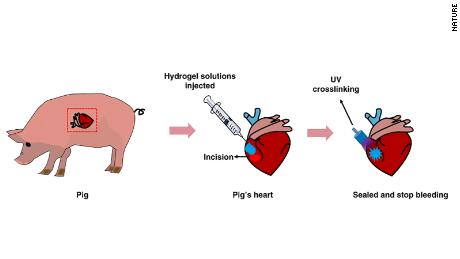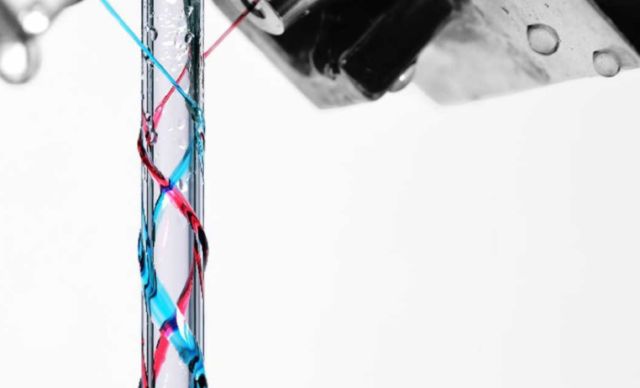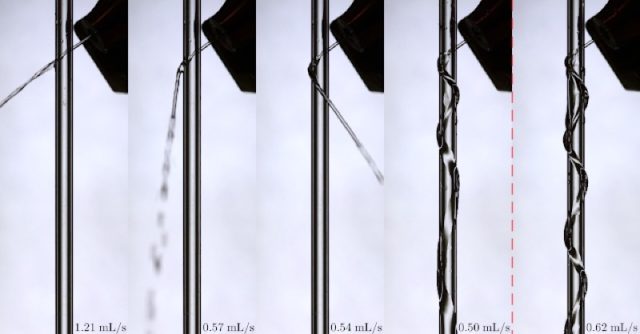Previous 1 ... 3 4 5 6 7 8 9 ... 74 Next
I'm sure science hasn't "proved" that plastic pollution is real, or that it's caused by man.
They might have all fallen off a Crocs tree, and just been brought there by the tide . . .
Most plastic floats so it must be aquatic in nature. Thus not a form of pollution.
Those beach pollution pictures are staged. ![]()
Plastic Actors and Actresses showing up at all these different locations
All the Crisis rope and bottles too.

Uncontrolled bleeding during surgery can cause death. What if, instead of slow surgical stitching, you could rapidly glue a wound together?
A new "bio-glue" -- an experimental adhesive gel that is activated by a flash of light -- has been proven to stop high pressure bleeding in the hearts of pigs.
Additional research confirming the safety of this product is needed before experiments can begin in humans, according to the authors of a study published Wednesday in the journal Nature Communications.
Around the globe, more than 234 million surgeries are performed each year, the World Health Organization estimates.
Surgical suturing is especially difficult when dealing with diseased, damaged or small blood vessels, according to the study authors. Existing surgical products, such as Fibrin Glue and Surgiflo, have been effective in stopping bleeding during surgeries, but they take minutes to set and in some cases require additional stitching.
https://www.cnn.com/2019/05/15/health/b ... index.html
Study published at:
https://www.nature.com/articles/s41467-019-10004-7

Uncontrolled bleeding during surgery can cause death. What if, instead of slow surgical stitching, you could rapidly glue a wound together?
A new "bio-glue" -- an experimental adhesive gel that is activated by a flash of light -- has been proven to stop high pressure bleeding in the hearts of pigs.
Additional research confirming the safety of this product is needed before experiments can begin in humans, according to the authors of a study published Wednesday in the journal Nature Communications.
Around the globe, more than 234 million surgeries are performed each year, the World Health Organization estimates.
Surgical suturing is especially difficult when dealing with diseased, damaged or small blood vessels, according to the study authors. Existing surgical products, such as Fibrin Glue and Surgiflo, have been effective in stopping bleeding during surgeries, but they take minutes to set and in some cases require additional stitching.
https://www.cnn.com/2019/05/15/health/b ... index.html
Study published at:
https://www.nature.com/articles/s41467-019-10004-7
Finally. Something to mend this broken heart.
I see what you did there!
Tea drinkers know all too well that annoying dribble from the kettle spout that so often occurs as one pours a nice refreshing cuppa. It's even known as the "teapot effect," and it usually happens when the tea is poured too slowly. Potters usually design their pots—giving the spout a thin lip, for instance—to reduce the likelihood of dribbling, based on centuries of accrued knowledge derived from trial and error.
Now a group of Dutch physicists has come up with a quantitative model to accurately predict the precise flow rate for how much (or how little) a teapot will dribble as it pours, described in a recent paper in Physical Review Letters. The model accurately describes both the simple teapot effect and more complex behavior—notably, the formation of a helix as a water stream swirls around a cylinder. That should be a boon not just for teapot design, but for 3D printing and similar industrial applications, which are also plagued by inconvenient dribbling.
Physicists have long been fascinated by the phenomenon. The late Stanford engineer and mathematician Joseph B. Keller once recalled attending a lecture by an Israeli scientist who mentioned that he'd posed the question of why teapots dribble to 100 physicists. All opined that it must be due to surface tension, but when the Israeli scientist performed experiments to test that theory, this proved not to be the case.
Intrigued, Keller did his own investigation and concluded that the dripping was actually due to air pressure. He and a colleague, Jean-Marc Vanden‐Broeck, published a paper in 1986—work that earned them an Ig Nobel prize in 2012. "It is simply that at the pouring lip the pressure in the liquid is lower than the pressure in the surrounding air," Keller told the Etsy Journal in 2013 (he died in 2016). "So air pressure pushes the tea against the lip and against the outside of the spout."


https://arstechnica.com/science/2019/05 ... ot-effect/
Are you saying that Depends will soon be out of business? No more dribble no more depends. ![]()
Only if you dribble really fast. Slow dribbles in low air pressure are still caught.
Since 2013, annual emissions of a banned chlorofluorocarbon (CFC) have increased by around 7,000 tonnes from eastern China, according to new research published in Nature today [Wednesday 22 May 2019] by an international team of scientists from the UK, South Korea, Japan, USA, Australia and Switzerland.
Last year, it was reported that emissions of one of the most important ozone depleting substances, CFC-11, had increased. This chemical was used primarily as a foaming agent for building insulation, refrigerators and other consumer products. The surprise finding indicated that someone, somewhere was likely producing and emitting thousands of tonnes of CFC-11, despite a global phase-out since 2010 under the Montreal Protocol.
Dr. Matt Rigby, a lead author of the study and Reader in Atmospheric Chemistry in the School of Chemistry at the University of Bristol, explained: "Through global monitoring networks such as the Advanced Global Atmospheric Gases Experiment (AGAGE) and the National Oceanic and Atmospheric Administration Global Monitoring Division (NOAA GMD), scientists have been making measurements of chlorofluorocarbons (CFCs) in the atmosphere for over 40 years.
"In recent decades, we've primarily seen declining CFC emissions reflected in these measurements, because of the Montreal Protocol. Therefore, it was unexpected when it was reported last year that, starting around 2013, global emissions of one of the most important CFCs suddenly began to grow."
This finding was concerning because CFCs are the main culprits in depletion of the stratospheric ozone layer, which protects us from the sun's ultra-violet radiation. Any increase in emissions of CFCs will delay the time it takes for the ozone layer, and the Antarctic ozone "hole", to recover.
But where were these new emissions coming from? Until now, researchers only had an indication that at least part of the source was located somewhere in eastern Asia.
"Initially our monitoring stations were set up in remote locations, far from potential sources," said Ron Prinn, co-author of the new study, leader of the AGAGE network and professor at the Massachusetts Institute of Technology (MIT). "This was because we were interested in collecting air samples that were representative of the background atmosphere, so that we could monitor global changes in concentration and determine their atmospheric lifetimes."
To better pinpoint emissions sources, more recent measurement stations have been located closer to industrialised regions. In this case, the clue to the location of the new CFC-11 emissions came from an AGAGE station in South Korea and an AGAGE-affiliated station run by the National Institute of Environmental Studies (NIES) in Japan.

. . .
Previous reports by the Environmental Investigation Agency and the New York Times have suggested that Chinese foam manufacturers were using CFC-11 after the global ban. Furthermore, Chinese authorities have recently identified and closed down some illegal production facilities.
Whilst this new study cannot determine which industry or industries are responsible, it provides a clear indication of large increases in emissions of CFC-11 from China in recent years. These increases, likely from new production, account for a substantial fraction of the concurrent global emission rise.
https://phys.org/news/2019-05-source-cfc-emissions.html
Researchers of the Schliesser Lab at the Niels Bohr Institute, University of Copenhagen, have pushed the precision of force and position measurements into a new regime. Their experiment is the first to surpass the so-called "Standard Quantum Limit," or SQL, which arises in the most common (and successful) optical techniques for ultra-precise position measurements. For more than 50 years, experimentalists have raced to beat the SQL using a variety of techniques, but to no avail. In their recent work, the researchers at the Niels Bohr Institute have done the trick with a simple modification of the standard approach, which enables the necessary cancellation of quantum noise in the measurement. The result and underlying experiment have potential implications for gravitational wave astronomy techniques, as well as force microscopy with biological applications. The work is now published in the prestigious scientific magazine, Nature Physics.
The trouble with quantum noise
Quantum actions have quantum consequences. In the context of measurements, this often means that the very act of measuring a quantum system disturbs it. This effect is referred to as 'backaction," and is a consequence of fundamental quantum uncertainties, first conceived by Werner Heisenberg during his stay at Niels Bohr's Copenhagen Institute in the 1920s. In many instances, this sets a limit to how precise a measurement can get.
Gravitational wave telescopes like LIGO, the Laser Interferometer Gravitational-Wave Observatory, whose discoveries were awarded the 2017 Physics Nobel prize, bounce laser light off a mirror to measure its position, in an optical configuration known as an interferometer. The "imprecision" of this measurement can be improved by increasing the laser power, but eventually the random kicks of the laser photons will disturb the mirror position, leading to a less-sensitive measurement which leaves faint or distant astronomical objects undetected. By optimally balancing the imprecision noise and backaction, one can reach a minimum amount of extra noise, establishing the "Standard Quantum Limit' (SQL). This minimum noise level sets the best precision possible by any conventional interferometer.
To get around this limit, one must modify the interferometer in some way to avoid these quantum noise sources. In the 50 years since the SQL was established, various proposals have been put forth, and recent years have brought several proof-of-principle experimental demonstrations. So far, no experiment has actually measured the position of an object with a precision which beats the SQL. But this is precisely what the Copenhagen team has accomplished, thanks to advanced optical and nanomechanical techniques.
https://phys.org/news/2019-05-quantum-l ... ition.html
Yes....measure twice, cut once.
Previous 1 ... 3 4 5 6 7 8 9 ... 74 Next